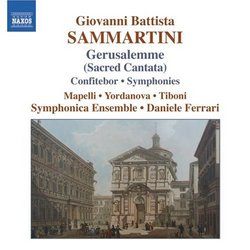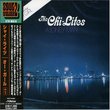| All Artists: Giovanni Battista Sammartini, Daniele Ferrari, Symphonica Ensemble, Filippo Ravizza, Miroslava Yordanova, Silvia Mapelli, Giorgio Tiboni Title: Sammartini: Gerusalemme Members Wishing: 0 Total Copies: 0 Label: Naxos Original Release Date: 1/1/2007 Re-Release Date: 1/30/2007 Genres: Pop, Classical Styles: Vocal Pop, Opera & Classical Vocal, Historical Periods, Classical (c.1770-1830), Symphonies Number of Discs: 1 SwapaCD Credits: 1 UPC: 747313025374 |
Search - Giovanni Battista Sammartini, Daniele Ferrari, Symphonica Ensemble :: Sammartini: Gerusalemme
 | Giovanni Battista Sammartini, Daniele Ferrari, Symphonica Ensemble Sammartini: Gerusalemme Genres: Pop, Classical
|
Larger Image |
CD DetailsSimilar CDs
|
CD ReviewsHistory or Music? Giordano Bruno | Wherever I am, I am. | 11/30/2008 (4 out of 5 stars) "You'll have to choose. Sammartini's Lenten cantata Gerusalemme forces the choice. The full title is informative: "Gerusalemme sconoscente ingrata: Libretto de la Perfidia giudaica nella SS. Passione di Gesu Cristo." In English: "Ungrateful and Ignorant Jerusalem: Libretto of Jewish Wickedness in the most Holy Passion of Jesus Christ." In short, this is an example of exalted art serving despicable ends, a cantata performed in Milan at the Jesuit Church of San Fedele, asserting the standard anti-Semitic accusation against all Jews as Christ-killers and persistent enemies of the Christian truth. Sammartini maintained a 50-year involvement with the Congregation of the Holy Sepulchre, an organization which consciously fomented anti-Jewish hatred and oppression. Eight of Sammartini's surviving sacred cantatas were written for Lenten services, following which 'popular' demonstrations against the local Jews were sanctioned by the Church and the municipalities. Here's the text of the concluding trio of this cantata, sung by a 'chorus of angels':
Faithless, senseless Zion, you know not what fateful blow will all too soon fall upon your head; you will weep at your cruel destruction but, when righteous vengeance comes, your tears will be too late. The notes that accompany this CD, written by Maria Daniela Villa, argue that such odious sentiments "might tempt us to let [the cantata] fall into complete oblivion. This though would be to incur an even greater error: that of forgetting not just the original wrong, but also the warning not to repeat past mistakes that comes precisely from remembering and reflecting on them. In the end the universal value of music prevails..." You'll have to address that issue for yourselves. Conductor Daniele Ferrari is vigorously staking claim to being the prime advocate for and interpreter of the music of G.B. Sammartini (1700-1775). Ferrari hears Sammartini as the central transitional composer between the Baroque and the Classical styles of music. In fact, Sammartini was both the teacher of Gluck and the model of symphonic composition for the young Mozart. Sammartini was 32 years older than Haydn and 56 years old when Mozart was born; given those facts, his symphonic manner does seem remarkably forward-looking. His symphonies, usually in three movements, would not be overshadowed in the company of Haydn's first 75 or Mozart's first 25. So far, Ferrari has produced three CDs for Naxos featuring the sacred cantatas of Sammartini, and all three are decent performances, not quite at the level of La Risonanza or Il Seminario Musicale, but easily the best versions of Sammartini available. In his efforts to make Sammartini sound as close to Haydn/Mozart as possible, Ferrari emphasizes the robust breadth of Sammartini's style, sometimes at the cost of the Baroque sprightliness and elegance another conductor might discover. The instrumental Symphonica Ensemble sounds at times more 19th C Conservatory than 18th C salon. Likewise, the singers Ferrari employs -- on this disk soprano Silvia Mapelli, mezzo Miroslava Yordanova, and tenor Giorgio Tiboni -- are clearly operatically trained, perhaps more at home with Mozart and Rossini than with the earlier vocal techniques of the baroque era. Mapelli is the most satisfying, but all three are really quite excellent. Only on the terzetto sections do I find a problem, in that their bel canto vibratos obscure the chordal progressions and fail to achieve the 'affect' of harmonically resolved cadences. If you're eager to fill in your musical overview of the 18th Century by adding Sammartini to your favorites, I'd suggest another CD from the same ensemble - In Pianto degli Angeli della Pace - which to my ears is musically more enjoyable and which doesn't carry a burden of history." |

 Track Listings (15) - Disc #1
Track Listings (15) - Disc #1


